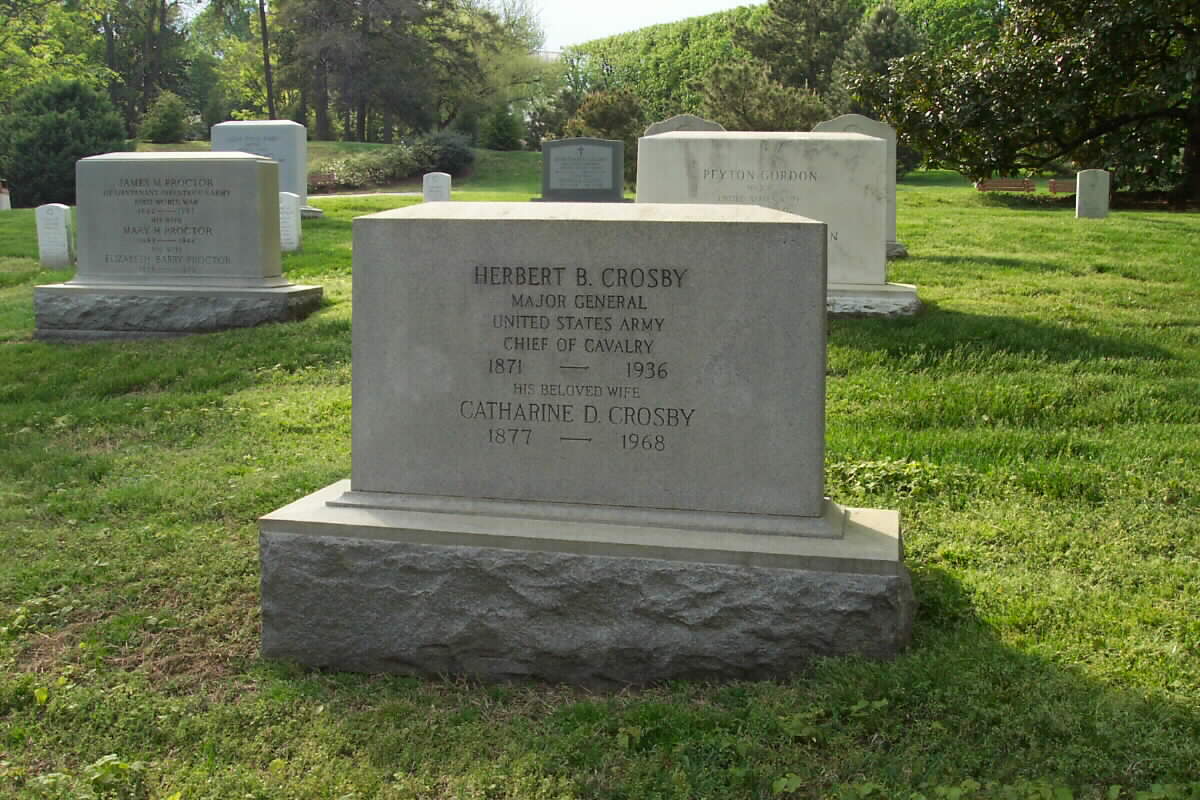Courtesy of Michael Stein:
Major General Herbert Ball Crosby, U.S. Army
Born December 24, 1871 in Fairmount, Kansas
Died January 11, 1936
Cadet, U.S. Military Academy 1889-93
Graduated with Class of 1893
Second Lieutenant 1893
First Lieutenant 1899
Captain 1901
Major 1916
Lieutenant Colonel 1917
Colonel (NA) 1917
Lieutenant Colonel 1919
Colonel 1920
Major General 1926
Served with 8th Cavalry Regiment 1893-01
Served with 14th Cavalry Regiment 1901-12
Regimental Commissary, 14th Cavalry Regiment 1907-08
On Recruiting duty 1909-11
Served with 8th Cavalry Regiment 1912-15
Served with 1st Cavalry Regiment 1915-17
Commanding Officer, 351st Infantry Regiment 1917-19
Student, School of the Line 1919-20
Student, General Staff School 1920-21
Instructor, General Staff School 1921-22
Student, Army War College 1922-23
Assistant Commandant, Army War College 1923-26
Chief of Cavalry 1926-30
Retired March 21, 1930
Appointed Commissioner of District of Washington 1930-33
Married Catharine Adelaide Dakin February 11, 1902. Children: George Dakin, Richard Lansing, Jane & Gordon Willard.
Herbert B. Crosby was born in 1871 and died in 1936. He was buried with full military honors in Arlington National Cemetery. His wife, Catharine D. Crosby (1877-1968) is buried with him.
Major General Herbert B. Crosby, Chief of Cavalry, 21 March 1926-20 March 1930.
Of course, the cavalry's isolation from the currents of technological change did not last. The first in a series of changes that would ultimately lead cavalrymen to rethink the issue mechanization came in 1927. That year the Chief of Cavalry, Maj. Gen. Herbert B. Crosby, recommended, and Secretary of War Dwight Davis approved, the addition of a small number of tanks and antitank weapons to the existing cavalry division. Otherwise, cavalrymen saw few modern vehicles. Each of the fifteen Regular Army horse cavalry regiments possessed only a handful of passenger cars for administrative transportation. More significantly, Davis' November visit to the British Experimental Mechanized Force engerized American mechanization policy. He watched the unit defeat a mixed infantry and cavalry force three times its size in less than forty-eight hours of operations. Impressed by what he had seen, Davis returned and ordered the U.S. Army to conduct its own tests.
In the late 1920s, Maj. Gen. Herbert B. Crosby, the Chief of Cavalry dutifully supported the General Staff's plan for a permanent mechanized force. Only Maj. Gen. Stephen O. Fuqua, the Chief of Infantry, raised objections; he feared the plan would rob his own branch of its control over tanks and tank development. Davis approved the plan over Fuqua's objections. In the meantime, the deadline for fiscal year 1930 budget submissions had already passed, so Davis delayed the plan's implementation for a year. The report called for $1 million in new equipment procurement for the mechanized force each fiscal year from 1931 through 1933.
As he ended his tour as the Chief of Cavalry, Crosby expressed his feelings about mechanization to students and faculty of the Cavalry School. He attacked the opponents of mechanization within the arm. Crosby argued that mechanization was “the greatest friend of cavalry just as the air service is. Mechanization will create a greater demand for Cavalry than ever before.” His comment on the value of the airplane to cavalry reflected the widely-held belief that aircraft freed the arm of the difficult task of long range reconnaissance, allowing them to focus on close reconnaissance and tasks in the main battle area. No doubt some cynic in the audience said to himself the last thing cavalry needed was more friends like the Air Corps! Other senior officers help spread the word. The Chief of the Operations Section of the General Staff drew direct parallels between tanks and the traditional forms of cavalry in his talks on mechanization. He told his audiences that the Mechanized Force was specifically tested how well tanks could fill the light cavalry role. Maj. Gen. Edward L. King's remarks were so direct, they demanded traditional cavalrymen sit up and take notice of the new force.
CROSBY, HERBERT B
MAJOR GEN USARMY RETIRED
- DATE OF DEATH: 01/11/1936
- BURIED AT: SECTION 6 SITE 5013
ARLINGTON NATIONAL CEMETERY
Michael Robert Patterson was born in Arlington and is the son of a former officer of the US Army. So it was no wonder that sooner or later his interests drew him to American history and especially to American military history. Many of his articles can be found on renowned portals like the New York Times, Washingtonpost or Wikipedia.
Reviewed by: Michael Howard

